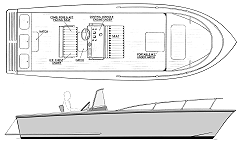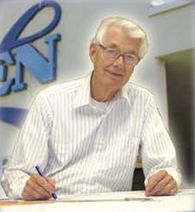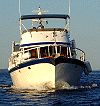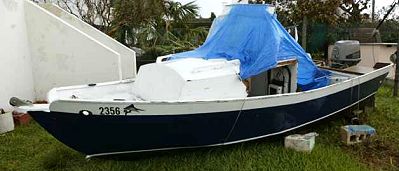

A place to share YOUR boat building story
Glen-L Marine Designs - 9152 Rosecrans Ave. - Bellflower, CA 90706

In this issue
- I wish you had...
- Designer's Notebook: Unusual Uses for Poxy-Shield
- How much does a set of plans cost?
- Latest Photos
- New Sugar Jack! by Al Seymour Jr.
- Carved Canoe Paddle by Uncle Don of Alaska
- Boat Building with Plywood by Glen-L poet laureate ArtDeco
- Shop Talk: Questions
- Future Boat Builders by Dave Black
- Recent email
GLEN-L Update
- Web site:
- Featured design next issue: Fancy Free. If you have any photos, facts or stories, I HOPE you'll share them with our readers. Please send them in NOW...
- New feature: "Boat Building with Plywood" from our poet laureate, ArtDeco.
- Another new feature was requested by a reader... "why not have a list of the latest photos sent in by builders".
- We will soon be replacing our current shopping cart with what we hope will be an improvement and offer several features that the current cart does not have. Gayle and Darla have been getting all the data ready. As soon as everything is ready, it's my turn. There may be some initial problems, but we hope to keep these to a minimum. We really believe that this will be an improvement.
- Thanks to our old friend Al Seymour Jr. for the update on his Cabin Skiff and to all the others who contributed to this WebLetter.
Editor
I wish you had...
I wish you had a 17' electric boat...
Picture yourself in this little beauty, gliding alone with the whisper of the electric motor, guiding her course with an outboard rudder, and a great cabin for camping...
Builders often ask for the boat we haven't got, without realizing that with a few minor changes, their perfect boat is right there before them. Most sailboats are displacement hulls, just what you want in an electric boat, an efficient hull. The "electric" boat pictured above is the Glen-L 17 sailboat, sans centerboard, mast and rigging. You could use "wheel" steering if you wanted, but my choice would be the outboard rudder. It's cheaper and looks really cool. If you intend to use a sailboat as a power boat, the hulls can usually be extended up to 10%. We do not recommend extending them if they are used as sailboats. The Whitehall (rowing boat) would also be ideal for electric power. We do not have details for this application in the plans, but the hulls are there for the innovative builder.


Center console... Look at the Key West center console... Look at the Monsoon cabin cruiser... do they look similar? They are the same hull. Eliminating the cabin and making an open "utility" hull is something that can easily be done. If you look through customer photos, you will find that cabins are often modified, and even eliminated.
So maybe that perfect boat you wish we had is right there on our site. The hull is the critical part, reasonable changes above the sheer are almost always possible.
Designer's Notebook: Unusual Uses for Poxy-Shield
Theory is great but experience is the best teacher. At Glen-L we are constantly experimenting as a matter of business, but also in our private lives. I have a small farm, ranch, or whatever with a pond. I have a golf cart, which I use as a carry all. On the space for the golf clubs I decided a removable box to carry the "pickups" constantly being gathered would be great. The box had to be light, removable, and durable as it would be removed and thrown on the dump area to remove its contents. I got together with Allyn and we decided to use cheap underlayment plywood of about 5/32" thickness. The bottom would be ¼" plywood with drainage holes; the rim reinforced with plywood and a 1" lumber "hook" to hold it on the cart. We didn't like the idea of using cleats at the corners, so we decided to try fillets made from POXY-SHIELD epoxy resin. No fasteners were used except a few small brads to hold the bottom in place during the filleting. The sides were held with temporary masking tape on the outside; no permanent fasteners. A 1" radius fillet was used on all interior junctions made from the activated resin, blended with two parts microspheres and one part silica to a heavy batter consistency. No fiberglass reinforcement was used. The entire box was epoxy encapsulated and finished with a couple coats of left over varnish. Big deal, "now I can make a box", you may be saying. True. but that box has now been in use for SEVEN years. All that time in the open, no cover; the cart with box was mostly stored under trees. No further touch up paint or maintenance and it's been treated roughly. But, it's still in one piece and being used; the POXY-SHIELD is doing the job. Another experience we had was different to say the least. Stream water is used to provide water to the pond. A 55 gallon steel barrel was used as a settling tank to eliminate much of the silt. A 4" plastic elbow drain was inserted through the bottom and held, you guessed it, with POXY-SHIELD and a couple layers of fiberglass tape. At the time, more than twenty years ago, we had no experience using epoxy for metal to plastic bonding and had serious doubts as to the longevity of the junction. About five years later a big rainstorm washed away the barrel. End of story? Not at all. I was doing some excavating down stream a short time ago and spotted a white object buried in the silt. There was our elbow; the steel barrel long gone. But, the portion of the elbow epoxied to the barrel was still there. Well rusted but still attached after more than twenty years in a watery condition, some of it tumbling through the water. Once you become familiar with this great product, you will find your own special uses for Poxy-Shield. Do you wonder why we are enthusiastic about the bonding powers of our Poxy Shield? |
How much does a set of plans cost?
How much does it cost... really? You bought the Plans and Patterns for the Malahini: $76.00. Before ordering, you called and talked to someone at Glen-L, asking questions about the design (5 minutes). After getting the plans, you call and ask questions about how the planking contour is determined (5 minutes). During the construction, you call with questions. Some of these require our getting the patterns out and spreading them on the floor so that we can see what you are talking about... (5, 10, 15, even 20 minutes? Not uncommon.)
Someone recently called with questions about the Console Skiff and I didn't know the answer, so I asked Allyn to talk to the builder. After he hung up, 25 minutes later, Allyn remarked that it has been years since he built the Console Skiff and he had to get out the patterns and instructions to remind himself how it was done. Different designs, different building methods... why something is notched or not notched or whether the floor timber is 1/2" or 3/4" plywood, usually requires spreading out the plans and patterns to check.
How much are we paying this "expert" per hour? Remember, the plans cost $76. And someone was paid to process and ship the order. The only way this scenario works is if we have a lot of people who never call or we sell other stuff. We like what we do, but it is labor intensive, and no one is going to get rich doing it.
These musings started after reading comments on the Boatbuilder Connection regarding Ken Hankinson's abrupt retirement. So why did Ken retire so abruptly? Ken loved designing boats. But every day many of the same questions come in and like us, Ken offered free support. Ours is a business that doesn't leave much "away time". How should he have left... I don't know. It would be nice if we had his designs available for all those who had book marked pages on Ken's site... Maybe we'll talk to him about it next time he passes this way... we don't have a way to contact him either.
Photos sent in since the last WebLetter... |
New Sugar Jack!by Al Seymour Jr.Many moons ago, the spring of 1993 to be exact, I purchased plans and patterns for the Cabin Skiff. I had a most enjoyable time building the boat, with my inspiration being the thoughts of cruising the crystal clear waters around Bermuda zipping through my head. I launched the boat in the summer of 1996. Being the second of only two Glen-L skiffs in Bermuda, the Sugar Jack got a lot of looks as she came into Mangrove Bay. However, in 2003 a combination of wood rot and hurricane Fabian decimated the boat.
Hurricane Fabian damage |
Carved Canoe Paddle
by Uncle Don of Alaska

This is My First attempt carving a Bird. You have
No Idea of the time it takes to Carve and Burn this little Sucker into an Old
Canoe Paddle. I really need a softer Wood to work with. At any rate, this is
what I ended up with. It's supposed to be a Black Capped Chickadee. I had
to fill My Bird Feeder twice to get them close enough to view. This is what I
do when there is No Snow and the Temperature is 42 above Zero! Holy Cow,
We're warmer up here than most of You?? "What's the
Deal"
Be Well, Uncle Don.
 Roses are red, Violets are blue I lost my ass When I sat in the glue... Don't know why they didn't make me the poet. I got a lot more where that one came from. |
Shop Talk: Questions
QUESTION:And, with your plans using fore and aft bulkheads, what about filling them with foam for flotation and eliminating the plugs?
ANSWER: Skip the flotation. It adds weight and offers less flotation value than a sealed compartment.
Glen proofed this and said, "that's not exactly true...". I should have labeled it, "opinion". The Coast Guard prefers foam. Why?Let's assume you have a sealed, non-foamed, chamber. It does have more flotation value, but should you hit something that pokes a hole in the hull and there was a leak in the compartment, it could conceivably fill with water and the hull would eventually sink. The hull breach could also breach the chamber... If this is a small sailboat (as in this case), sailing in the bay, can you imagine a realistic condition in which this might occur? Neither can I, short of being run over by a much larger boat, in which case you've probably got more to worry about than a breach in the hull. If this were a boat going out to the Channel Islands (30 miles), I might look at it differently. ...brw
QUESTION:
I have some questions about weight of engines. When some of your older designs were first introduced, most engines were two strokes and weighed within 10% to 15% of each other. Today's engines are heavier, especially the four strokes. It is possible to put a "40HP" on a boat that is 100 lbs+ more than an older Merc 40. Is there any rule of thumb? Also, it seems common for people to put more power on a design than your recommendations. So, if you took a design that had a 50HP rec. and wanted to put a 75-85 on it, you could be more than doubling the weight...???
ANSWER: The maximum hp on outboards is based upon the US Boating and Safety Act. The act uses a formula based solely on dimensions of the boat. If you exceed these recommendations, you may not be able to get insurance. The heavier motors may cause balance problems that can often be addressed by shifting weight forward. Excess weight at the transom can also cause porpoising, which can be addressed with cavitaion plates or hydrofoils on the motor. However, not all boats are meant to go 60 mph. Small boats in particular are almost completely out of the water at high speeds, a sudden bump in the road can cause you to lose control. Small increases in horsepower are usually possible, but discretion should be used. In particular, it is unwise to have excessive power on boats that will be operated by children. I would add that the limitations in the Act referenced above does not apply to race boats. It is assumed that these drivers are professionals, who know what they are doing.
Future Boat Builders
by Dave Black
We like to publicize projects in schools that feature boatbuilding as a teaching tool. This project does not use Glen-L plans and uses methods that are closer to "production" methods than what the majority of our builders will be using, but we do agree with Dave's contention that more attention should be given to wood shop and other vocational classes at the high school level. ...brwI am new to teaching, having come from being a network designer of 25 years to my hobby of wood working as a shop teacher. This is now my second year. For the first time I think I have time to plan and reflect rather than just react.
I had originally envisioned students building projects such as china closets or furniture, but when I asked how much money they had to spend on projects, it wasn't much. They had the money for the Lab fees, but not much more. So I decided to start a class project, something labor intensive that would involve many students, yet didn't cost too much to build. The decision on what the project would be was made when I looked in my garage and saw 600 pounds of fiberglass and knew that I had to use it up in some way. The project would be a boat mold in which I could use up my fiberglass... to build a boat. Boat building is something that can fire the imagination in a way that making a bread board can't.
Once the mold is made, future students could use the fiberglass to build a boat based on the labors of this year (05,06). As yet we don't know how much it will cost, but hopefully it will be within the budget of the students. Two students in the current class are fishermen and have plans for a partnership in a single boat. It's 13 feet long and 42 inches at the widest point. It should hold 1000 pounds.

Recent email:
Subject: Minnesota Messabout
Date: 20 Jan 2006
Several people who have built boats from your plans are from Minnesota and Wisconsin. I'd like to invite them to the 2006 Minnesota Messabout at Lake Pepin on June 2-4. Any suggestions on how I can reach them by email?
Here's a link to the event website: http://www.paxtonconsulting.com/2006_MN_Messabout.html That site contains a link to the DuckWorks Magazine article about last year's event.
It would sure be great to have some Glen-L boats at our messabout. Any help you can provide would be appreciated.
Bill Paxton
Apple Valley, MN
Subject: "Mist Miss"
Date: Wed, 11 Jan 2006
Fifty years ago, this coming December, two 20 year old farm boys started
building one of your "Mist Miss" boats from plans purchased from you.
I guess we had as much "fun" building this beautiful craft as
"enjoying" it over the next 35 years. Then, it began to leak very
badly, and got left sitting for 15 years. Now, I am determined to put it back
into "top" condition for the next 50 years. ( I was one of those farm
boys). We fibre-glassed the hull when new, dry and clean. We also sprayed the
inside dry wood with penta wood preserver before painting. It has never shown
any rot. ....Our original engine was a 1955 Chev. 265 V8, that is still in the
boat. However, I hope to place a much higher H.P. "Stroker Chev V8"
in it. I guess that one of the "high lights" of this adventure, was
to personally meet Mr. Glen Witt and his son, at your Bellflower office, back
in l978 while enjoying Disneyland. I was truly blessed in selecting a Glen L
plan (Mist Miss) for our project. For many years, back in the l960's it was
the finest boat in Southern Alberta (Waterton Lakes, Glacier Park).
Thank you.
Wray Swanson
Milk River, Alberta, Canada
Date: 1 Jan 2006
Subject: Project registry information
MONACO / Rich Coey / Modesto, California /
Started 06/11/05. I am using white oak for the frames and okoume plywood for
the first layers of planking. I bought a 1967 fiberglass Century Resorter, not
original so not worth much, but is perfect for parts for the Monaco. It came
with a newly rebuilt 5.7 Chevy and velvet drive transmission, a new trailer and
all the other hardware I need, even the strut is the right size and angle. I
usually just have weekends and holidays to work on the boat. On 12/31/05, I
finished the first layer of planking, 258 hours to date. This has been a
lot of fun so far.
Subject: Update of Robert Zopp's Minuet "Sweet Pea" for
Product Registry
Date: Wed, 28 Dec 2005
Barry,
I have been working slowly over the past several months, but the frames are
all cut out. I had to cut out Frame #1's floor frame twice because of a
measuring mistake. I was still able to get all the frames cut from the 35 bft.
of Mahogany. I have ordered a gallon of epoxy and silica fillers. Intending to
assemble frames soon. I have also ordered my first 1/3 of my silicon bronze
fasteners from Glen-L. Transferred the transom, stem, floor boards, and
breasthook to the 3/4" plywood. Also, the centerboard has been fabricated
and galvanized. I have put together a yahoo photo album and here is the
address:
http://pg.photos.yahoo.com/ph/razopp/my_photos
I intend to continue posting updated photos on the photo site, and have been active on the BoatBuilder Connection. A very interesting crowd in there.
Thanks for the great service.Robert
Subject: Tubby
Date: Wed, 21 Dec 2005
Hi Gayle, This last weekend I epoxied the bottom of Tubby and let it dry,
applied the cloth and three coats of epoxy, drying between coats. Everything
went great. Monday morning at 5:30 AM I applied another coat. It was nice out,
shirt sleeves in Florida, but a couple of hours later it went down in the 60s
got rainy and has been cool and damp ever since. It is under cover and never
got wet. It is now Wednesday and the resin is still a little bit tacky. If it
warms up will it harden properly? Do I need to get heat on the boat. Maybe I
need to get a heat lamp under the boat? Your advice will be very helpful.
Thanks again. Fred.
First, we must assume that the final coat had the proper mix of resin/hardener. You might check the mixing container, if it is still around. It should be set up.
There is "tacky" and "oily". When there is high
humidity, the amine blush can be more pronounced (oily). This can be wiped off
with acetone, laquer thinner, denatured alcohol...
If truly "tacky" and the mixture was correct, it should harden when
it warms up. Since you started at 5:30 AM, the resin would have been at
nighttime temperature. Depending how low this was, the resin might not have
started to react before temps dropped. With 60 degree resin at 60 degree temp,
I would have expected it to go off within the day. Heating would help, but try
to check the mixing container.
Subject: Re: Boat Trailer
Date: Wed, 21 Dec 2005
Thanks Gayle:
I just submitted my order.
BTW: I found your book "How to Build a Boat Trailer" very useful. I no longer have any misgivings about making the trailer strong enough and safe to haul.
Best,Rob
Subject: Glen-L 19 project update
Date: Tue, 20 Dec 2005
Builder: Darrell Stotts
Project Glen-L 19 sailboat
A lot of progress made since last update on my project. Basically I am about
completed, with the exception of the cabin interior. Wooden mast and boom is
completed with hardware installed. All exterior hardware installed. Hull is
painted with final coats. Cushions were made to order per my templates. Cabin
windows installed, sliding hatch completed and installed (user modification
from stock plans). I’ve even purchased the trailer on which she will
rest. Everyone who has seem her is amazed and I must admit I spend a fair
amount of time just looking at her. After 4 years of work she is finally going
to see the water. I’ve kept record of every penny spent. Sometime in the
near future I’ll publish the stats on what was spent. I think that I have
about 2500 hours into the build process. I also have taken many photos of the
entire build process, of which I will also submit in the future.
Things left to do: Install electrical system and lights. Purchase rigging and
sails. Have one big task yet. Transfer from building cradle to trailer and as I
don’t know how to sail, take sailing lessons. Hey, if you can build a
sailboat how hard can it be to learn to sail one? I’ll let you know how
she sails in the coming spring, after the lessons.
Subject: Console Modification
Date: Thu, 15 Dec 2005
Hi Barry, I just finished building the console for the Console Skiff, I love
the style of it because it seems to go well with a wooden boat. One
modification I wish that I had made is shown below. The original design has the
front seating area at 90% to the seat itself which doesn’t make for a
very comfortable chair, especially when the head rest in installed. The new
modification allows you to lean back. Just providing feedback.
Regards,
Matt Marzullo
Don't know if this makes any sense... The challenge would be in the details. ...brw
Subject: Disappointment
Date: Fri, 16 Dec 2005
Reference Lyttle Industries Inc.;
Your website shows no material prices, which should be included under the
heading "order/check prices." This heading references plan prices
only. Include these prices in future webpages. The fact that currently,
material prices are non-existant indicates that you only care about making a
profit for plans that you sell and that you have no concern for the buyer and
what he/she might encounter at the register while the materials are being rung
up at the local lumber supplier. Americans have been through enough. Don't
rip us off, not during the holiday season; it is extremely inappropriate.
Subject: Have a Merry Christmas
Date: Tue, 13 Dec 2005
Please keep sending me newsletters. I enjoy them. My wife and I are going to start on a boat in 2006 but haven't made our mind up on which model. Please keep up the good work and you all have pulled quite the boating crowd together. Again may all of you there have a wonderful Christmas! Dana Crook
Obviously, all of you who are reading this are the "boating crowd".
Build more boats
GLEN-L boats, of course















